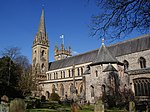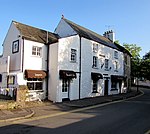Food Industry Centre
AC with 0 elementsCardiff Metropolitan UniversityFood science institutesResearch institutes in WalesUnited Kingdom university stubs ... and 2 more
Use British English from May 2015Welsh organisation stubs

The Food Industry Centre (FIC) at Cardiff Metropolitan University (also known as UWIC) is a Welsh research and education organisation designed to address issues of food safety and food-related health concerns. Its mission also includes supporting the Welsh food industry. The centre, which is part of UWIC's Cardiff School of Health Sciences at the university's Llandaff campus, was launched in 1999. A new facility for the centre opened on 21 April 2009 and was built at a cost of £5,000,000.
Excerpt from the Wikipedia article Food Industry Centre (License: CC BY-SA 3.0, Authors, Images).Food Industry Centre
Western Avenue, Cardiff Llandaff
Geographical coordinates (GPS) Address Nearby Places Show on map
Geographical coordinates (GPS)
| Latitude | Longitude |
|---|---|
| N 51.496 ° | E -3.212 ° |
Address
Lecture Theatre (A0.31)
Western Avenue
CF5 2YB Cardiff, Llandaff
Wales, United Kingdom
Open on Google Maps










